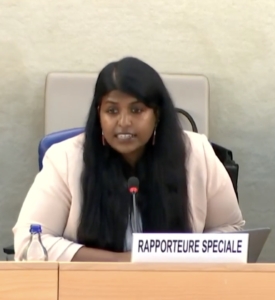A groundbreaking new report by the UN Special Rapporteur on Racism, Ashwini KP, has issued a powerful call to action, identifying caste and gender among the core drivers of intersectional oppression, particularly in South Asia. The report, presented to the Human Rights Council by the Special Rapporteur in an Interactive Dialogue on 3 July, emphasizes that to truly fight discrimination, we must embrace an intersectional approach that understands how different forms of prejudice, like caste and gender combine with poverty and other factors, to create unique and devastating experiences of injustice and marginalisation.

Ashiwini KP speaking at the ID
Speaking at the Interactive Dialogue on behalf of IDSN, Abirami Jotheeswaran, commended the Special Rapporteur on the report highlighting the “tripartite marginalisation” of caste, gender and poverty. Ms. Jotheeswaran urged all Member States to:
- To consult diverse Dalit women in empowerment
- To collect disaggregated data by caste, gender, disability and sexual
- To ensure legal frameworks reflect intersectional realities, especially
- To strengthen justice systems to prevent and address caste and gender-based violence, with afocus on Dalit women, LGBTQ+ persons and children with
In her oral presentation to the Human Rights Council, the Special Rapporteur also highlighted caste repeatedly and that caste oppressed communities are disproportionately affected and this is further exacerbated due to the lack of policies with an intersectional approach.
The report makes it clear: caste and gender oppression and discrimination are not isolated issues but deeply interconnected forms of systemic violence. It highlights how understanding the concept of intersectionality is vital for unmasking the complex layers of discrimination and exclusion. The report also details how one-size-fits-all solutions simply don’t work, because the experiences of caste-oppressed communities are highly complex and varied. An intersectional lens helps to challenge harmful stereotypes and portrayals of these communities as homogenous. The report also highlights the need to challenge hate-speech online as well as offline.
Take-aways on caste and gender intersectionality from the report
- “Tripartite Marginalisation” in South Asia: In countries like Bangladesh, India, Nepal, Pakistan and Sri Lanka, Dalits face overlapping discrimination due to factors such as caste, gender, sexual orientation, economic status, disability and religion. This multi-layered disadvantage severely restricts their access to basic rights.
- Hazardous Labour: Dalit women are disproportionately forced into dangerous and informal jobs, most notably manual scavenging. The vast majority of those engaged in this degrading work are Dalit women, who are then denied access to basic necessities like clean water, healthcare, and other goods and services.
- Violence with Impunity: Caste and gender-based violence are rampant, serving to reinforce oppressive social hierarchies. This violence often goes unpunished due to systemic discrimination within justice systems. Examples include trafficking and forced prostitution, sexual violence against Dalit women as a tool of caste oppression, and forced religious conversions or marriages. In Nepal, a significant number of human trafficking survivors are Dalit women, with Badi Dalit women being especially vulnerable due to historical prejudices. LGBTQ+ Dalit individuals also face high risks of physical and sexual violence, and Dalit children endure severe social exclusion and corporal punishment in schools.
- Dalit Women and mainstream feminist movements: Dalit feminist scholars have tirelessly brought to light the specific social, sexual and cultural contexts that shape Dalit women’s lives. They show how Dalit women’s bodies, identities and work have been historically controlled and exploited. The report notes that Dalit women are often marginalised even within feminist academic circles, underscoring that any feminist movement that ignores caste is fundamentally flawed and complicit in perpetuating caste hierarchies.
The Special Rapporteur outlines essential elements to tackle discrimination:
- Understand the roots: It’s vital to conduct systemic, racial and historical analyses of oppression, including caste. The report warns against a superficial use of “intersectionality” without truly dissecting the power systems and privilege that fuel inequality. Without this, the concept risks losing its power to dismantle systemic discrimination.
- Listen to affected communities: The diverse experiences of those facing caste discrimination must be central to all efforts. Full and effective participation of caste-oppressed communities in all policy and decision-making spaces is non-negotiable. The report highlights a worrying trend: Dalit communities experience low representation in policymaking in India.
- Collect disaggregated data: Gathering data that is disaggregated by race, ethnicity, and caste, among other identities, is described as a critical tool. This “intersectional data” is powerful because it makes invisible communities and their struggles visible, challenges stereotypes and exposes systemic disparities.
- Demand justice and reparation: Laws must be expanded to include all forms of intersectional discrimination. Beyond this, the report champions comprehensive and structural reparatory justice approaches. These are crucial for acknowledging and fully addressing the harms of historical atrocities, especially those related to caste oppression. True justice, the report asserts, must be grounded in the lived experiences of those who have suffered systemic racism and intersectional discrimination.
The report concludes by stressing that international human rights law already obliges States to take an intersectional approach. It urges governments worldwide to take bold and urgent action, including significant investment in reparatory justice, to address historical wrongs and ongoing structures of racial inequality, discrimination and oppression.
